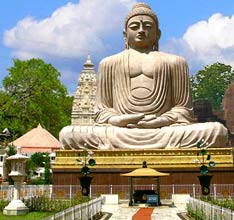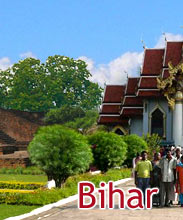 Madhubani paintings as the name says get its name from Mithila region of Bihar where it is widely practised particularly by women. The history of Madhubani paintings goes back to the time of Ramayana when King Janak commissioned artists to do paintings at the time of marriage of his daughter, Sita, to Lord Ram. Initially women of upper castes like Brahmans and Kayasthas were using such paintings but later on followed by other castes also. Originally the painting was done on freshly plastered mud wall of huts, but now it is also done on cloth, hand-made paper and canvas.
Madhubani paintings as the name says get its name from Mithila region of Bihar where it is widely practised particularly by women. The history of Madhubani paintings goes back to the time of Ramayana when King Janak commissioned artists to do paintings at the time of marriage of his daughter, Sita, to Lord Ram. Initially women of upper castes like Brahmans and Kayasthas were using such paintings but later on followed by other castes also. Originally the painting was done on freshly plastered mud wall of huts, but now it is also done on cloth, hand-made paper and canvas. Madhubani painting mostly depict nature and Hindu religious figures and the themes generally associated with Hindu deities, Natural objects like sun, moon, and religious plants like tulsi. Besides this scenes from the royal court and social events like weddings are also widely drawn. Madhubani Paintings has two varieties: Bhittichitra and Aripana. Generally Bhittichitra is done on the mud-walls of houses particularly at three places: room of the family god/goddess, room of the newly wedded couple and the drawing room. Also Paintings are done on the outer and inner walls of these rooms on some auspicious occasions like marriage, upnayana and festivities like Dussehra and Deepawali.
Figures that are widely used are figures of various god and goddesses depicting Durga, Kali, Ram and Sita, Radha and Krishna, Shiva and Parvati, Gauri and Ganesha, the ten incarnations of Vishnu. Besides these pictures of Sun and Moon are also painted because it is believed that they bring prosperity and joy to the family. Other figures used are figures of various animals, birds, leaves, flowers, plants along with symbols of swastika, shankha. Mostly used colours in these paintings are deep colours like red, green, blue and black. Besides, deep colours other colours like yellow, pink, and lemon are also used. All these colours are prepared by indigenous methods form some household products like banana leaves, milk and vermilion.
The other type of painting practiced by the women folk of Bihar is known as "Aripana” or "Alpana" which stands for line drawings on the floor of the House. Originally the purpose of this Aripana was to make the cultivated land fertile and fruitfully by magical performances. However as now Aripana are done on the eve of certain rituals or ceremonies such as Puja, Vrata, and Samskara. This type of paintings has a special feature that these are drawn fresh and new on each and every occasion especially in the courtyard, door front and other important places. In fact presence and popularity of Shakti cult in eastern India particularly in Bihar and West Bengal which was very popular during Gupta and Post-Gupta era is clearly and visibly manifested in the Aripana paintings.










